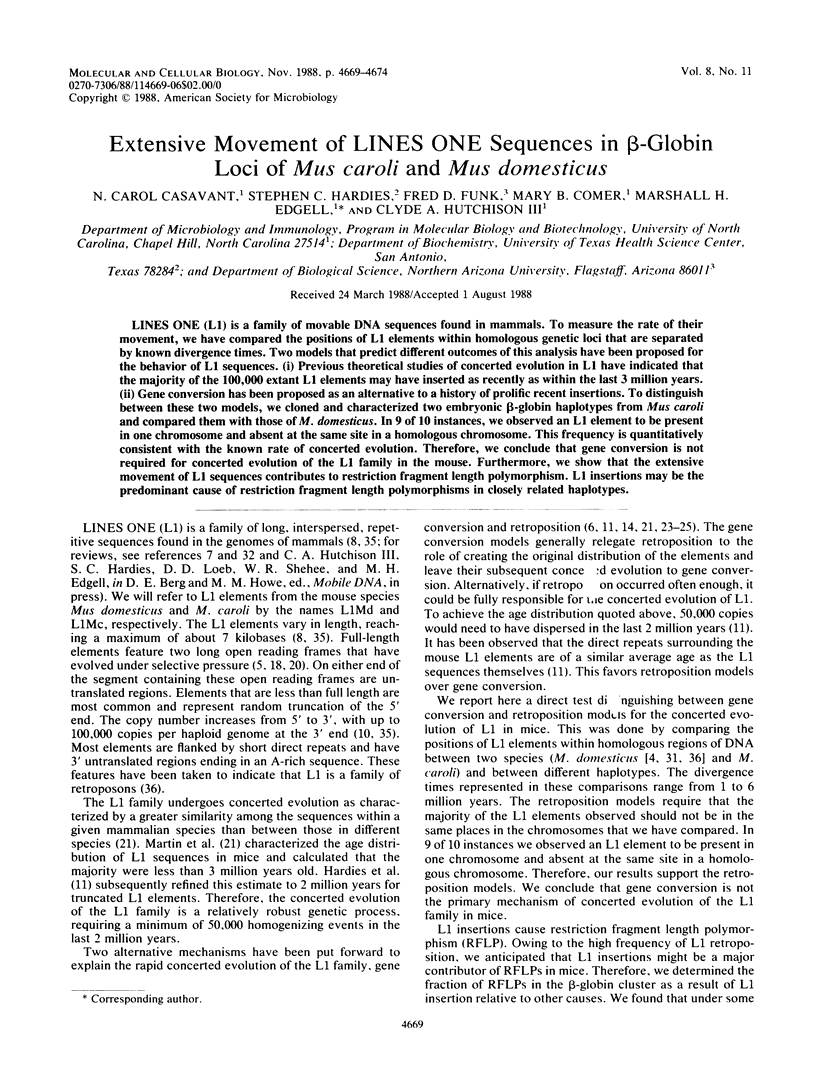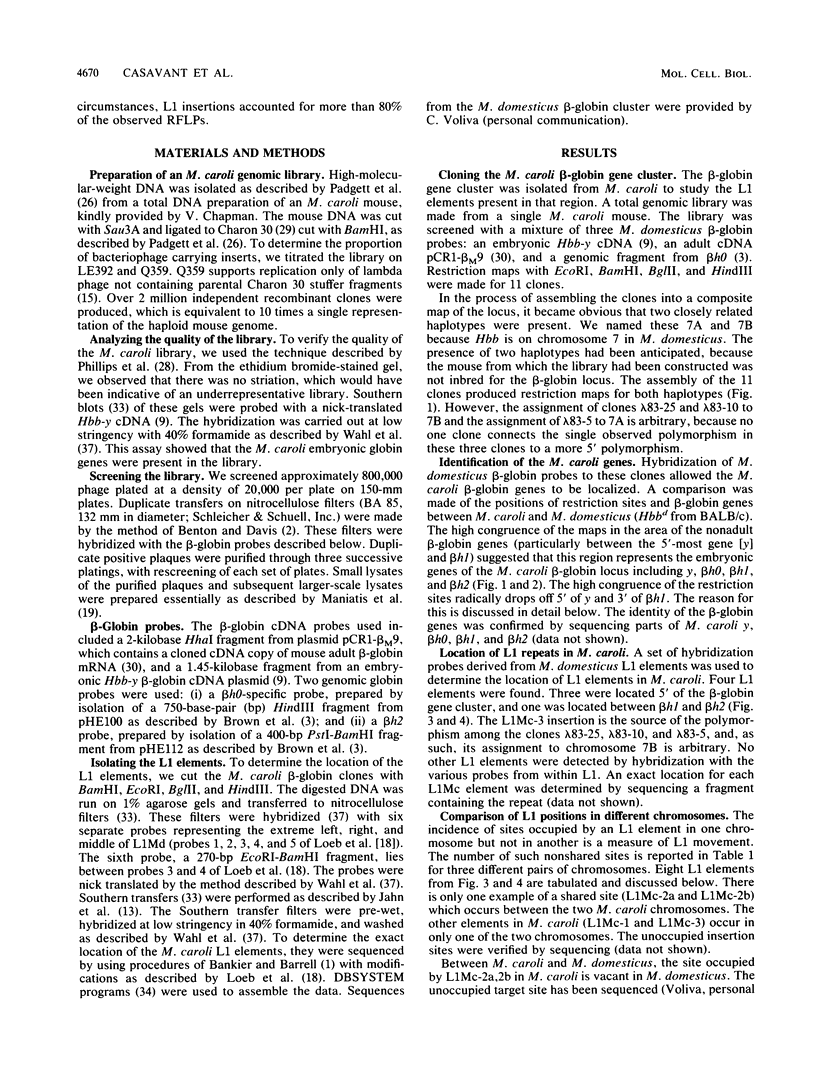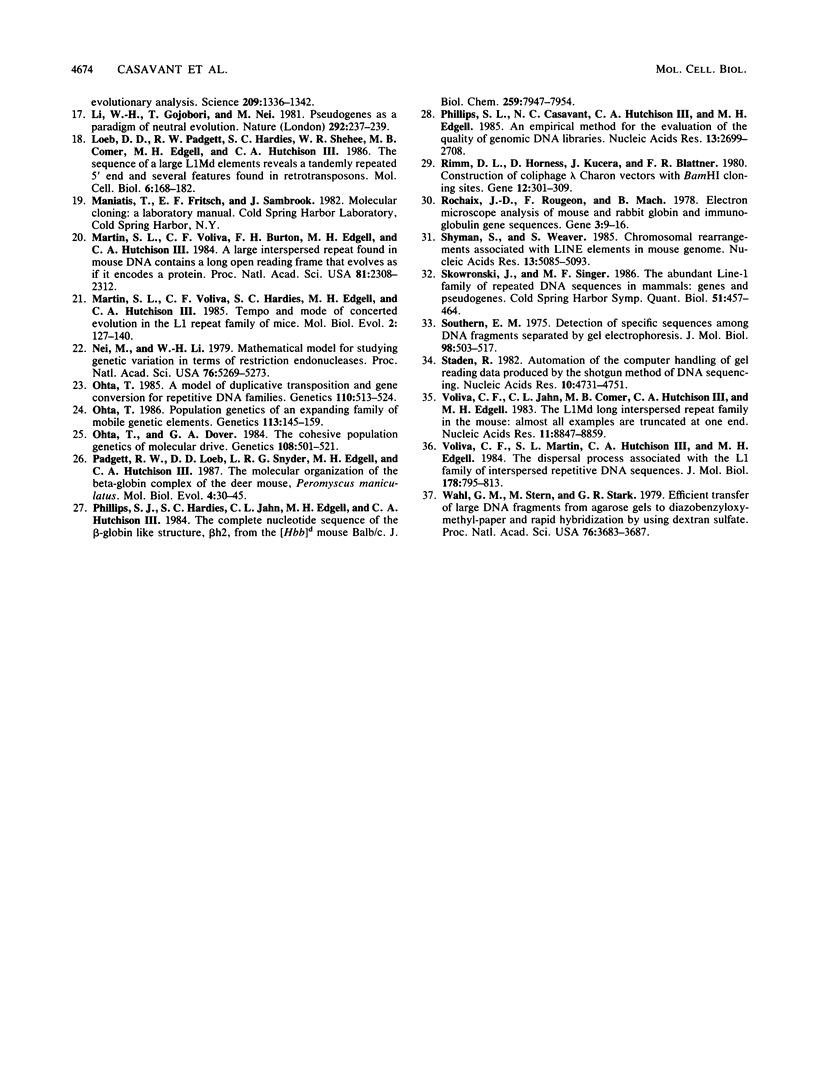Abstract
LINES ONE (L1) is a family of movable DNA sequences found in mammals. To measure the rate of their movement, we have compared the positions of L1 elements within homologous genetic loci that are separated by known divergence times. Two models that predict different outcomes of this analysis have been proposed for the behavior of L1 sequences. (i) Previous theoretical studies of concerted evolution in L1 have indicated that the majority of the 100,000 extant L1 elements may have inserted as recently as within the last 3 million years. (ii) Gene conversion has been proposed as an alternative to a history of prolific recent insertions. To distinguish between these two models, we cloned and characterized two embryonic beta-globin haplotypes from Mus caroli and compared them with those of M. domesticus. In 9 of 10 instances, we observed an L1 element to be present in one chromosome and absent at the same site in a homologous chromosome. This frequency is quantitatively consistent with the known rate of concerted evolution. Therefore, we conclude that gene conversion is not required for concerted evolution of the L1 family in the mouse. Furthermore, we show that the extensive movement of L1 sequences contributes to restriction fragment length polymorphism. L1 insertions may be the predominant cause of restriction fragment length polymorphisms in closely related haplotypes.
Full text
PDF





Selected References
These references are in PubMed. This may not be the complete list of references from this article.
- Benton W. D., Davis R. W. Screening lambdagt recombinant clones by hybridization to single plaques in situ. Science. 1977 Apr 8;196(4286):180–182. doi: 10.1126/science.322279. [DOI] [PubMed] [Google Scholar]
- Brown B. A., Padgett R. W., Hardies S. C., Hutchison C. A., 3rd, Edgell M. H. beta-globin transcript found in induced murine erythroleukemia cells is homologous to the beta h0 and beta h1 genes. Proc Natl Acad Sci U S A. 1982 May;79(9):2753–2757. doi: 10.1073/pnas.79.9.2753. [DOI] [PMC free article] [PubMed] [Google Scholar]
- Burton F. H., Loeb D. D., Chao S. F., Hutchison C. A., 3rd, Edgell M. H. Transposition of a long member of the L1 major interspersed DNA family into the mouse beta globin gene locus. Nucleic Acids Res. 1985 Jul 25;13(14):5071–5084. doi: 10.1093/nar/13.14.5071. [DOI] [PMC free article] [PubMed] [Google Scholar]
- Burton F. H., Loeb D. D., Voliva C. F., Martin S. L., Edgell M. H., Hutchison C. A., 3rd Conservation throughout mammalia and extensive protein-encoding capacity of the highly repeated DNA long interspersed sequence one. J Mol Biol. 1986 Jan 20;187(2):291–304. doi: 10.1016/0022-2836(86)90235-4. [DOI] [PubMed] [Google Scholar]
- Dover G. Molecular drive: a cohesive mode of species evolution. Nature. 1982 Sep 9;299(5879):111–117. doi: 10.1038/299111a0. [DOI] [PubMed] [Google Scholar]
- Edgell M. H., Hardies S. C., Loeb D. D., Shehee W. R., Padgett R. W., Burton F. H., Comer M. B., Casavant N. C., Funk F. D., Hutchison C. A., 3rd The L1 family in mice. Prog Clin Biol Res. 1987;251:107–129. [PubMed] [Google Scholar]
- Fanning T. G. Size and structure of the highly repetitive BAM HI element in mice. Nucleic Acids Res. 1983 Aug 11;11(15):5073–5091. doi: 10.1093/nar/11.15.5073. [DOI] [PMC free article] [PubMed] [Google Scholar]
- Fantoni A., Bozzoni I., Ullu E., Farace M. G. Construction of a recombinant bacterial plasmid containing DNA sequences for a mouse embryonic globin chain. Nucleic Acids Res. 1979 Aug 10;6(11):3505–3517. doi: 10.1093/nar/6.11.3505. [DOI] [PMC free article] [PubMed] [Google Scholar]
- Gebhard W., Meitinger T., Höchtl J., Zachau H. G. A new family of interspersed repetitive DNA sequences in the mouse genome. J Mol Biol. 1982 May 25;157(3):453–471. doi: 10.1016/0022-2836(82)90471-5. [DOI] [PubMed] [Google Scholar]
- Hardies S. C., Martin S. L., Voliva C. F., Hutchison C. A., 3rd, Edgell M. H. An analysis of replacement and synonymous changes in the rodent L1 repeat family. Mol Biol Evol. 1986 Mar;3(2):109–125. doi: 10.1093/oxfordjournals.molbev.a040386. [DOI] [PubMed] [Google Scholar]
- Hill A., Hardies S. C., Phillips S. J., Davis M. G., Hutchison C. A., 3rd, Edgell M. H. Two mouse early embryonic beta-globin gene sequences. Evolution of the nonadult beta-globins. J Biol Chem. 1984 Mar 25;259(6):3739–3747. [PubMed] [Google Scholar]
- Jahn C. L., Hutchison C. A., 3rd, Phillips S. J., Weaver S., Haigwood N. L., Voliva C. F., Edgell M. H. DNA sequence organization of the beta-globin complex in the BALB/c mouse. Cell. 1980 Aug;21(1):159–168. doi: 10.1016/0092-8674(80)90123-3. [DOI] [PubMed] [Google Scholar]
- Jubier-Maurin V., Wincker P., Cuny G., Roizès G. The relationships between the 5' end repeats and the largest members of the L1 interspersed repeated family in the mouse genome. Nucleic Acids Res. 1987 Sep 25;15(18):7395–7410. doi: 10.1093/nar/15.18.7395. [DOI] [PMC free article] [PubMed] [Google Scholar]
- Karn J., Brenner S., Barnett L., Cesareni G. Novel bacteriophage lambda cloning vector. Proc Natl Acad Sci U S A. 1980 Sep;77(9):5172–5176. doi: 10.1073/pnas.77.9.5172. [DOI] [PMC free article] [PubMed] [Google Scholar]
- Li W. H., Gojobori T., Nei M. Pseudogenes as a paradigm of neutral evolution. Nature. 1981 Jul 16;292(5820):237–239. doi: 10.1038/292237a0. [DOI] [PubMed] [Google Scholar]
- Loeb D. D., Padgett R. W., Hardies S. C., Shehee W. R., Comer M. B., Edgell M. H., Hutchison C. A., 3rd The sequence of a large L1Md element reveals a tandemly repeated 5' end and several features found in retrotransposons. Mol Cell Biol. 1986 Jan;6(1):168–182. doi: 10.1128/mcb.6.1.168. [DOI] [PMC free article] [PubMed] [Google Scholar]
- Martin S. L., Voliva C. F., Burton F. H., Edgell M. H., Hutchison C. A., 3rd A large interspersed repeat found in mouse DNA contains a long open reading frame that evolves as if it encodes a protein. Proc Natl Acad Sci U S A. 1984 Apr;81(8):2308–2312. doi: 10.1073/pnas.81.8.2308. [DOI] [PMC free article] [PubMed] [Google Scholar]
- Martin S. L., Voliva C. F., Hardies S. C., Edgell M. H., Hutchison C. A., 3rd Tempo and mode of concerted evolution in the L1 repeat family of mice. Mol Biol Evol. 1985 Mar;2(2):127–140. doi: 10.1093/oxfordjournals.molbev.a040340. [DOI] [PubMed] [Google Scholar]
- Nei M., Li W. H. Mathematical model for studying genetic variation in terms of restriction endonucleases. Proc Natl Acad Sci U S A. 1979 Oct;76(10):5269–5273. doi: 10.1073/pnas.76.10.5269. [DOI] [PMC free article] [PubMed] [Google Scholar]
- Ohta T. A model of duplicative transposition and gene conversion for repetitive DNA families. Genetics. 1985 Jul;110(3):513–524. doi: 10.1093/genetics/110.3.513. [DOI] [PMC free article] [PubMed] [Google Scholar]
- Ohta T., Dover G. A. The cohesive population genetics of molecular drive. Genetics. 1984 Oct;108(2):501–521. doi: 10.1093/genetics/108.2.501. [DOI] [PMC free article] [PubMed] [Google Scholar]
- Ohta T. Population genetics of an expanding family of mobile genetic elements. Genetics. 1986 May;113(1):145–159. doi: 10.1093/genetics/113.1.145. [DOI] [PMC free article] [PubMed] [Google Scholar]
- Padgett R. W., Loeb D. D., Snyder L. R., Edgell M. H., Hutchison C. A., 3rd The molecular organization of the beta-globin complex of the deer mouse, Peromyscus maniculatus. Mol Biol Evol. 1987 Jan;4(1):30–45. doi: 10.1093/oxfordjournals.molbev.a040425. [DOI] [PubMed] [Google Scholar]
- Phillips S. J., Hardies S. C., Jahn C. L., Edgell M. H., Hutchison C. A., 3rd The complete nucleotide sequence of a beta-globin-like structure, beta h2, from the [Hbb]d mouse BALB/c. J Biol Chem. 1984 Jun 25;259(12):7947–7954. [PubMed] [Google Scholar]
- Phillips S. L., Casavant N. C., Hutchison C. A., 3rd, Edgell M. H. An empirical method for the evaluation of the quality of genomic DNA libraries. Nucleic Acids Res. 1985 Apr 25;13(8):2699–2708. doi: 10.1093/nar/13.8.2699. [DOI] [PMC free article] [PubMed] [Google Scholar]
- Rimm D. L., Horness D., Kucera J., Blattner F. R. Construction of coliphage lambda Charon vectors with BamHI cloning sites. Gene. 1980 Dec;12(3-4):301–309. doi: 10.1016/0378-1119(80)90113-4. [DOI] [PubMed] [Google Scholar]
- Rochaix J. D., Rougeon F., Mach B. Electron microscope analysis of mouse and rabbit globin and immunoglobulin gene sequences. Gene. 1978 Feb;3(1):9–16. doi: 10.1016/0378-1119(78)90003-3. [DOI] [PubMed] [Google Scholar]
- Shyman S., Weaver S. Chromosomal rearrangements associated with LINE elements in the mouse genome. Nucleic Acids Res. 1985 Jul 25;13(14):5085–5093. doi: 10.1093/nar/13.14.5085. [DOI] [PMC free article] [PubMed] [Google Scholar]
- Skowronski J., Singer M. F. The abundant LINE-1 family of repeated DNA sequences in mammals: genes and pseudogenes. Cold Spring Harb Symp Quant Biol. 1986;51(Pt 1):457–464. doi: 10.1101/sqb.1986.051.01.055. [DOI] [PubMed] [Google Scholar]
- Southern E. M. Detection of specific sequences among DNA fragments separated by gel electrophoresis. J Mol Biol. 1975 Nov 5;98(3):503–517. doi: 10.1016/s0022-2836(75)80083-0. [DOI] [PubMed] [Google Scholar]
- Staden R. Automation of the computer handling of gel reading data produced by the shotgun method of DNA sequencing. Nucleic Acids Res. 1982 Aug 11;10(15):4731–4751. doi: 10.1093/nar/10.15.4731. [DOI] [PMC free article] [PubMed] [Google Scholar]
- Voliva C. F., Jahn C. L., Comer M. B., Hutchison C. A., 3rd, Edgell M. H. The L1Md long interspersed repeat family in the mouse: almost all examples are truncated at one end. Nucleic Acids Res. 1983 Dec 20;11(24):8847–8859. doi: 10.1093/nar/11.24.8847. [DOI] [PMC free article] [PubMed] [Google Scholar]
- Voliva C. F., Martin S. L., Hutchison C. A., 3rd, Edgell M. H. Dispersal process associated with the L1 family of interspersed repetitive DNA sequences. J Mol Biol. 1984 Oct 5;178(4):795–813. doi: 10.1016/0022-2836(84)90312-7. [DOI] [PubMed] [Google Scholar]
- Wahl G. M., Stern M., Stark G. R. Efficient transfer of large DNA fragments from agarose gels to diazobenzyloxymethyl-paper and rapid hybridization by using dextran sulfate. Proc Natl Acad Sci U S A. 1979 Aug;76(8):3683–3687. doi: 10.1073/pnas.76.8.3683. [DOI] [PMC free article] [PubMed] [Google Scholar]


